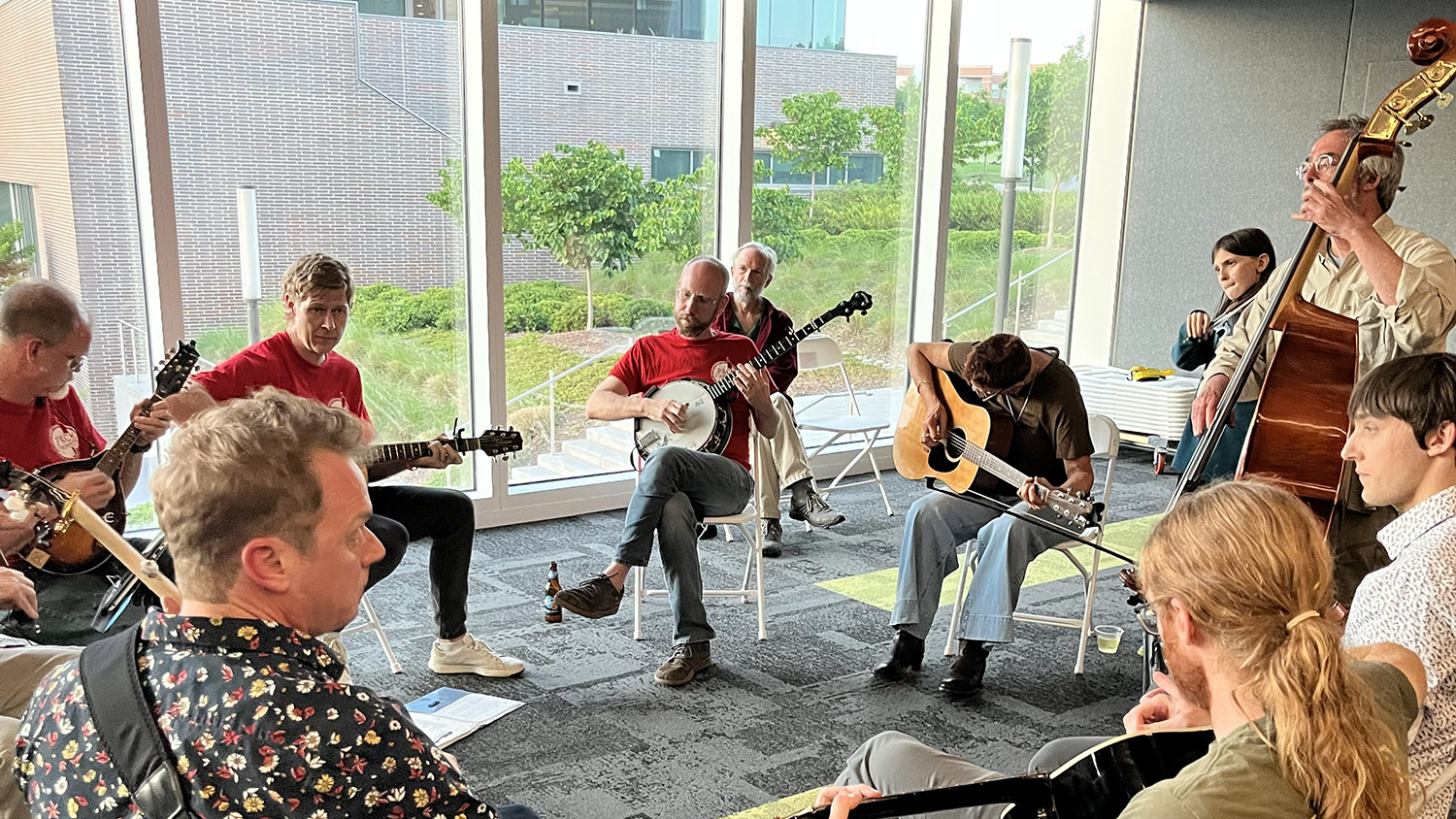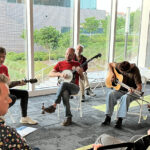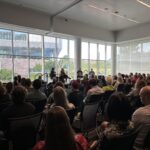Strings and the sciences came together at the Bluegrass and Interdisciplinarity event at the Hunt Library on May 21. Hosted by the Office of University Interdisciplinary Programs and NC State LIVE, the event welcomed more than 150 attendees for a night of blending music, impromptu dance and conversation about the insights that the tradition of bluegrass can offer to scientists and other scholars.
The evening began with esteemed bluegrass musicians and educators Hank Smith and Pattie Hopkins Kinlaw of Hank & Pattie, interspersed with questions from Liza Wade Green, interim director of NC State LIVE and Senior Vice Provost for University Interdisciplinary Programs Rob Dunn. The conversation considered the ways in which bluegrass performances, and bluegrass jams in particular, offer a metaphor for how interdisciplinary teams work together to solve problems.
Interdisciplinary Music-making
Dunn has spent hundreds of hours at bluegrass jams and other musical events that feature a mix of deep skill and creativity. In working with faculty, staff and students to integrate interdisciplinarity on campus, he often found himself envying the bluegrass approach to interdisciplinarity, particularly that found in bluegrass jams.
In the best jams, musicians come together to make music leveraging their thousands of hours of practice. Additionally, the individual musicians and instruments are like disciplines — they come together and play songs they know, but they don’t need to know each other (or even necessarily speak to each other).
“They work together through gestures and rules that are encoded in bluegrass, and do so in a way that allows an individual to take solos (“breaks”) if and when it makes sense,” said Dunn. “This is what we are after in interdisciplinarity. How do we bring the instruments of our disciplines together to make extraordinary music?”
Hank and Pattie wowed the crowd with their expertise blending musicianship and storytelling, playing three tunes meant to spark interdisciplinary creativity in participants. Dunn and Interim Director of NC State LIVE Liza Wade Green joined the duo onstage for a lively conversation covering the history of bluegrass music and instruments, how a jam session typically works, the growth and evolution of bluegrass music and how it overlaps with other musical genres, and how they approach songwriting and performing.
In a display of intergenerational learning, attendees of all ages, including some people who had never engaged in bluegrass before, joined in. Some of the best bluegrass musicians in the country were hidden in the mix, along with mathematicians from three universities, high school teachers, historians, archaeologists, scholars of medieval literature, a plumber, and two visiting graduate students from Princeton University with their German parents. Amidst all of this, people felt comfortable coming together and socializing, with new interdisciplinary collaborations being discussed.
Innovative Jam Session
Following Hank and Pattie’s performance, attendees turned their attention to the “bluegrass jam” portion of the event. Duke Energy Hall was partitioned into two large rooms, with a circle of chairs set up in each room to allow informal “jam circles.” Audience members were encouraged to bring their own instruments, with at least 40 people participating, as well as the Wolfpack Pickers, bluegrass musicians of all skill levels who are affiliated with NC State.
Local college student Kelsey Mueller engaged in improvised tap dancing to provide melody and baselines while others performed solos, and then she had her own solo while the instrumentalists provided a baseline. The jam session went well beyond the scheduled 9 p.m. stop time as attendees wanted to stay longer to experience the interdisciplinary innovation taking place.
“So much of the arts is inherently interdisciplinary, especially in the performing arts. The skills you gain from learning or experiencing the arts (collaboration, the importance of practice, exploration, and failure, working across languages, how to take and give feedback, how to listen, navigating creativity vs. rules) are all transferable skills for interdisciplinary education,” said Green.
Hitting the Right Notes
Of course, the bluegrass jam included some extraordinary musicians, with some beginners as well.
“It is simultaneously an act of art and an act of apprenticeship (intergenerational apprenticeship at that),” said Dunn. “This too is what we are after on campus. “And bluegrass is ‘of here’. In our region and state, bluegrass was born in ways that build on the histories of people here. If there is any place that should be able to learn from bluegrass to think about interdisciplinarity — really bluegrass and jazz — it is us.”
Green felt the excitement that permeated the room, with so many different ages represented at the event and in the bluegrass jam — elementary-aged children playing music with university students, staff, faculty members and retirees. The mix of the program gave many different people a way into the music.
“First, you could just listen to Hank & Pattie play and be drawn in by Pattie’s haunting voice and their expert playing. Then, the guided discussion gave us concrete examples of how Hank & Pattie are working across disciplines and within other cultural contexts,” she said. “And finally the two bluegrass jams were an opportunity for musicians to drop into the creative process and it gave the non-musicians in the room a chance to see the interdisciplinarity in action — all while mingling with folks from across the campus and the community.”
For those in attendance, it became obvious how bluegrass and interdisciplinarity mix.
“Art disrupts scientific practice and spurs new ideas. Often, scientific practice is a kind of art (the creative act). Artists help to depict science. Artists, also, move scientists,” said Dunn. “You don’t always need art for some kinds of incremental science or engineering. But, often, for great science that changes the world and helps to better humanity, art is integral.”
Through the Bluegrass and Interdisciplinarity event, these concepts converged for several hours. But taking a look at the way the arts and many other disciplines are embraced and supported throughout the university, interdisciplinarity is a way of life.





